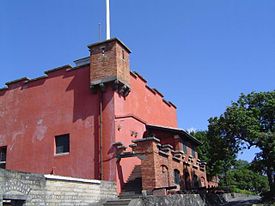Fort Santo Domingo
| Fort Anthonio | |
|---|---|
| Part of Museum Fort San Domingo | |
| Tamsui District, New Taipei City, Taiwan | |

Fort Anthonio. Part of Museum Fort San Domingo
|
|
| Type | Castle-like fort |
| Site history | |
| Built | 1644 |
| Built by | Spanish conquistadores / Dutch East India Company |
| In use | 1644–1868 |
| Materials | Stone and bricks |
| Fort San Domingo | |||||||||||
| Traditional Chinese | |||||||||||
|---|---|---|---|---|---|---|---|---|---|---|---|
|
|||||||||||
| Alternative Chinese name | |||||||||||
| Traditional Chinese | 聖多明哥城 | ||||||||||
|
|||||||||||
| Transcriptions | |
|---|---|
| Standard Mandarin | |
| Hanyu Pinyin | Hóngmáochéng |
| Southern Min | |
| Hokkien POJ | Âng-mn̂g-siâⁿ |
| Transcriptions | |
|---|---|
| Standard Mandarin | |
| Hanyu Pinyin | Shèng Duōmínggē chéng |
| Southern Min | |
| Hokkien POJ | Sèng Domingo Siâⁿ |
The Fort San Domingo was originally a wooden fort built by the Spanish in 1629 at Tamsui District, New Taipei City, Taiwan. It is located near Hobe Fort, which was built during Qing rule.
After the Spanish established a permanent colony at San Salvador (Palm Island; modern-day Hoping Island), they proceeded in 1629 to occupy Tamsui, "which even at this early period was frequented by many Chinese merchants, who came from Fokien to barter with the Formosa natives." On a night in 1636, a group of local people, angered by the taxes that the Spanish governor had imposed, successfully attacked the fort and demolished it. In 1637, the Spanish rebuilt the fort using stone and raised the walls' height to twenty feet or more. A church was also built on a hill, and the locals helped to make a road to it from the fort. "Peter Nuits the Dutch Governor of Formosa, reported these facts to his home authorities and exposed in an interesting report the injury that the Spaniards were doing to Dutch trade and the necessity of sending an expedition to drive them away."
After a failed first attempt in 1641, the Dutch made a second expedition on 3 August 1642: "the Dutch appeared off Tamsui with a comparatively powerful squadron of four frigates, a large cutter, nine small vessels, besides several transports..." After the Dutch mounted artillery at an elevation commanding the fort, they succeeded in taking the fort on 24 August. The Dutch also expelled the Spaniards from nearby Keelung. The Spanish fort in Tamsui had by then already been razed by the Spanish themselves. It is also claimed that no traces remain of the forts on Palm Island, as they were destroyed by Zheng Jing, son of Koxinga.
The Dutch then became the "undisputed masters of Formosa", and built a new fort on the site, called Fort Antonio. In 1644, they replaced it with the structure still standing today, also called Fort Antonio. The "Old Dutch Fort" made of brick and stone has been described as "impregnable against any engines of war that those early days could produce." The locals called the Dutch "the red-haired people", which led to the compound's Hokkien name (Chinese: 紅毛城; Pe̍h-ōe-jī: Âng-mn̂g-siâⁿ; literally: "ang mo fort").
...
Wikipedia
